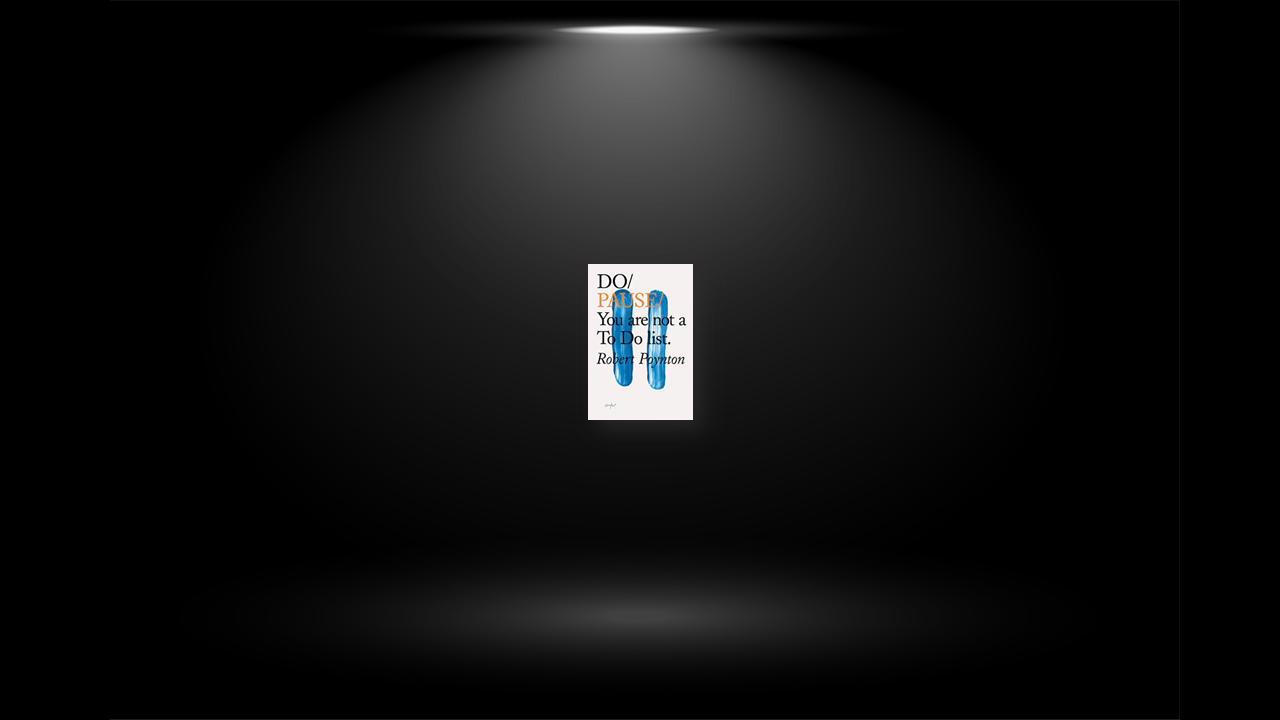Why Pause?
A pause is an opening. It acts as a portal to other options and choices, giving more dimension to your experience. Just as a small amount of yeast makes light of heavy dough, a small amount of pause here and there can leaven or lighten your life. You don’t need much but it is a vital ingredient.
Experimenting with pause gives you a way to play around with the rhythms of your life. It gives you a way to give shape and texture to your experience, weakening the sensation that your life is driven by external forces over which you have no influence. Choosing where you put your pauses makes an enormous difference to what your life feels like and what you can do as a result.
You might pause to rest and regenerate, to become more creative, to connect with other people or yourself, or just to enjoy whatever it is that is going on around you (or inside you). There are many possible reasons to pause, ways to pause and lengths of pause. There are many different practices you can adopt. You can play around to your heart’s desire and choose whatever suits you: pause is quite the opposite of a task to tick off. Pause is a very plastic concept. There is plenty to try, as we will see. It is a subtle, powerful, life-giving idea — one that is worth spending a little time with.
What’s in a Pause
There are obvious benefits of pause to your own wellbeing and sanity. This is an old idea; we know that ‘all work and no play’ makes for a dull life. Yet the pressure of modern life means it is a lesson we have to keep learning. It is breaking a taboo when a CEO like Andrew Mackenzie of BHP (one of Australia’s largest companies) publicly says ‘a rested Andrew can do more in four hours than a tired Andrew in eight’. Similarly, film director Dan Petrie’s top tip to people starting out in the trade was nothing technical or creative. It was: ‘get to bed before ten’.
Important though rest and regeneration may be, there are a wealth of other personal benefits. A pause is sometimes necessary to allow you to exercise your skill and judgement. Another film director, John Boorman, pauses while shooting so that he can bring his attention to his ‘instincts’. A doctor, in the midst of an operation, might pause for a couple of seconds, her finger on the carotid artery, in order to feel and sense the pulse, and make a critical decision about which of two drugs to administer. Access to these other intelligences requires our normal way of thinking to be quiet. Pause gives you access to capacities you might not know you have.
A pause can also help you to understand yourself better. On one retreat we asked people to spend a couple of hours outdoors in contemplation of a landscape. This was effectively a pause (the contemplation) within a pause (the retreat). One of the participants, who had recently left the corporate world, came back asking: ‘What if I think of my work, or career, as a field, not a path?’ This image gave him a completely different way to think about his work and how it might evolve.
Habits
One of the nicest things about pause is how obvious and familiar it is. You don’t need to go to a class or subscribe to any particular beliefs in order to understand it or start working with it. Anyone can think about where or how pauses show up, or are absent, in their own life or work without any prior knowledge or instruction. Pausing is very do-able, which is why it is a good subject for a book in this series.
Meditation, yoga, tai chi and mindfulness are all lovely in their own ways. But they do come with a bit of ‘wu-wu’ (as Nick Parker, writer and wordsmith, puts it), which can be a distraction or a barrier. Even if you are partial to a little ‘wu-wu’ every now and then, you still need a bit of instruction, language or technique in order to get going.
Not so with pause. Yet for all its ordinariness, pause has variety, depth and complexity. In this sense pause is like wine. Everyone understands what wine is (some of us rather too well) but within the category of wine, there are an infinite number of varieties. It means everyone can find their own way to pause. You can think about what is interesting or appropriate for you and start there.
Take a breath
An obvious place to start is with your breath, which connects body and mind. Since you are always breathing, the opportunity to use the breath is always at hand. When things get difficult or tense, you can simply ‘take a breath’ before speaking or responding. Shift your attention to your belly, softening it and letting it expand (instead of breathing from the chest), and take a gentle breath. By attending to your body for three or four seconds you can shift your mind and your mood.
Go outside
If breathing doesn’t work for you, try walking. Integral coach Justin Wise often suggests to his clients that two or three times a day they leave their desk, go outside and walk once around the block. At first they are self- conscious. It seems a ridiculous thing to do, but Justin will insist and, to keep them to it, he asks them to make a note of when they walk. Gradually, as the judgemental thoughts recede there is space for other responses — they start to notice how they are feeling in their body (an untapped source of information), get insights or have new ideas.
Since, like breathing, walking is something you do anyway, any kind of walking provides an opportunity to develop a practice of pause. Walking and thinking are intimately linked, so walking really does provide ‘pause for thought’. As you walk, it gives you the chance to metaphorically ‘walk around your ideas’, approaching them in different ways or looking at them from a different angle.
Count to one
Not ten, or even three, but one. That may seem insignificant, but to count to one, you have to pause. The important thing is to stop, not how long you stop for. That tiny interregnum has a similar effect to the bar across the bottom of the door: by checking you, it allows you to check in with how you are. I rather mischievously suggest this to people who are proud of how busy they are, because even they cannot claim they don’t have time to count to one.
Counting helps you hold silences, something many people find hard. If you count how long you are holding a silence for, you can see that it is never very long. A ten-second pause in a workshop — to allow people to digest an experience, or find the words to express something — is often enough, but it feels like an age. Having an objective measure of the length of a ‘pregnant’ pause helps you hold it for that bit longer. And after a bit of practice, it stops being uncomfortable altogether. Over time, you become able to tolerate more and longer silences. Which opens up all manner of new possibilities.
The daily routine
The journey to or from work is one such trigger. Instead of regarding the commute as a nuisance, why not see it as something you can take and use? For example, you can reframe traffic jams or delays as moments to pause.
This doesn’t necessarily imply becoming a saintlike figure, immune to the pressures of modern life. In fact, quite the opposite — you might pause in order to notice the frustration or impatience, and in so doing create a little space between you and those feelings, rather than letting them take possession of you.
You can choose to see the journey as an ‘in-between’ place in its own right (instead of as a waste of time). Regard it as a space not to be filled and deliberately avoid reading a book, listening to the radio or music, or checking email. See what occurs and what you notice — either about the journey, or about yourself.


